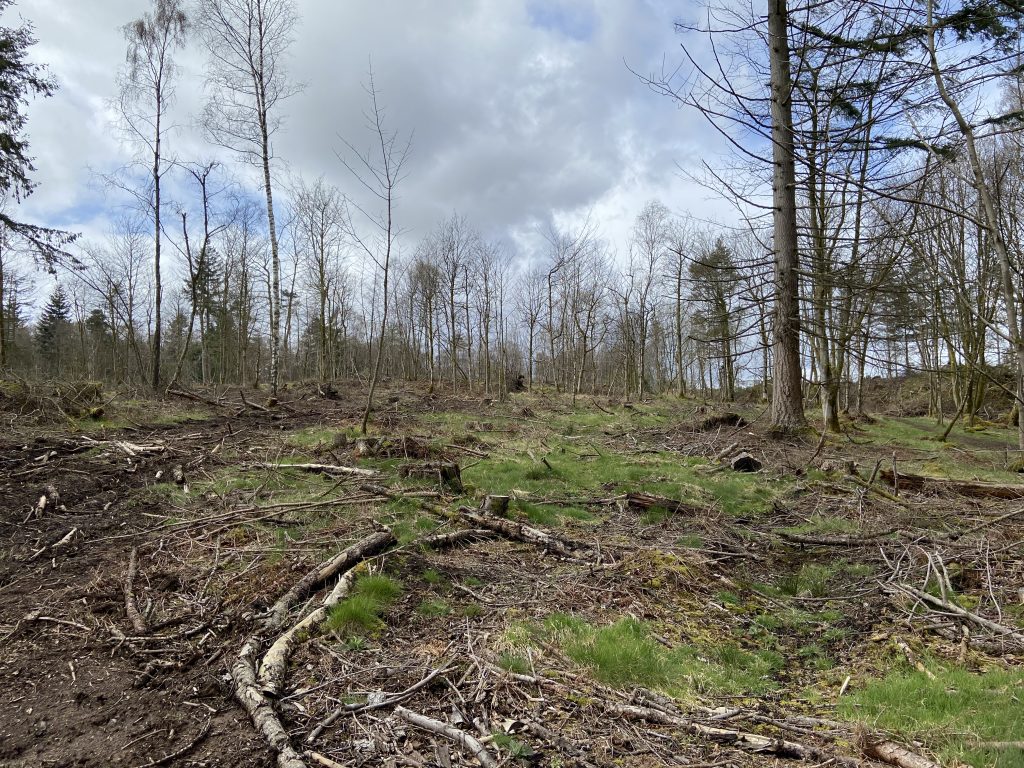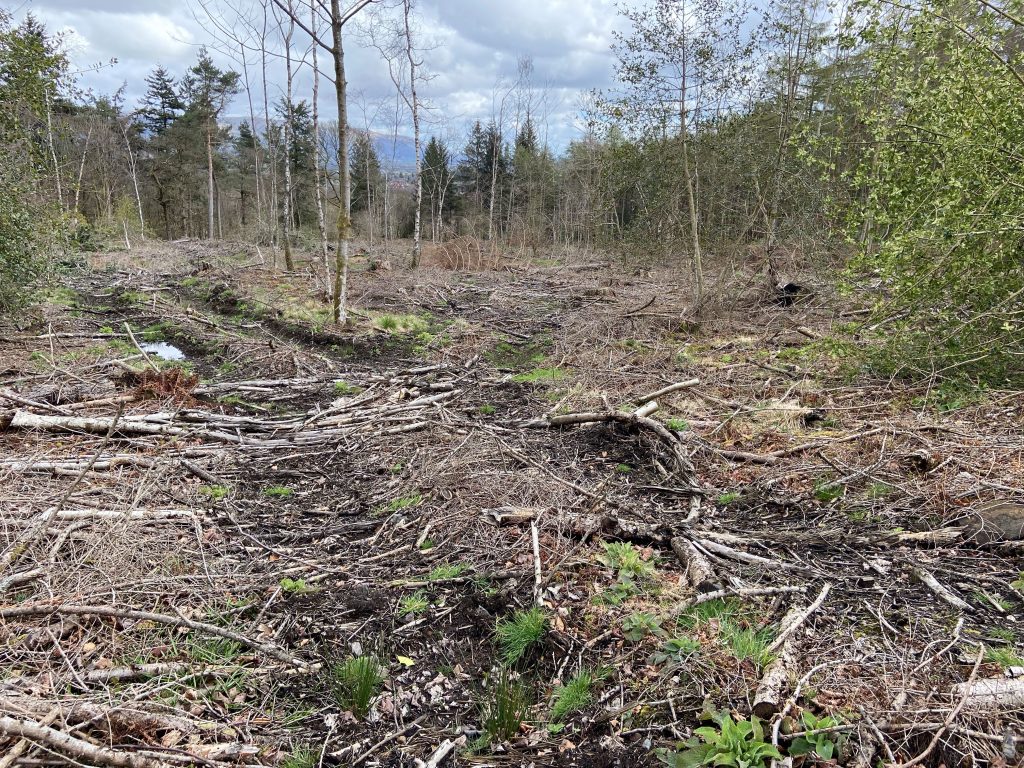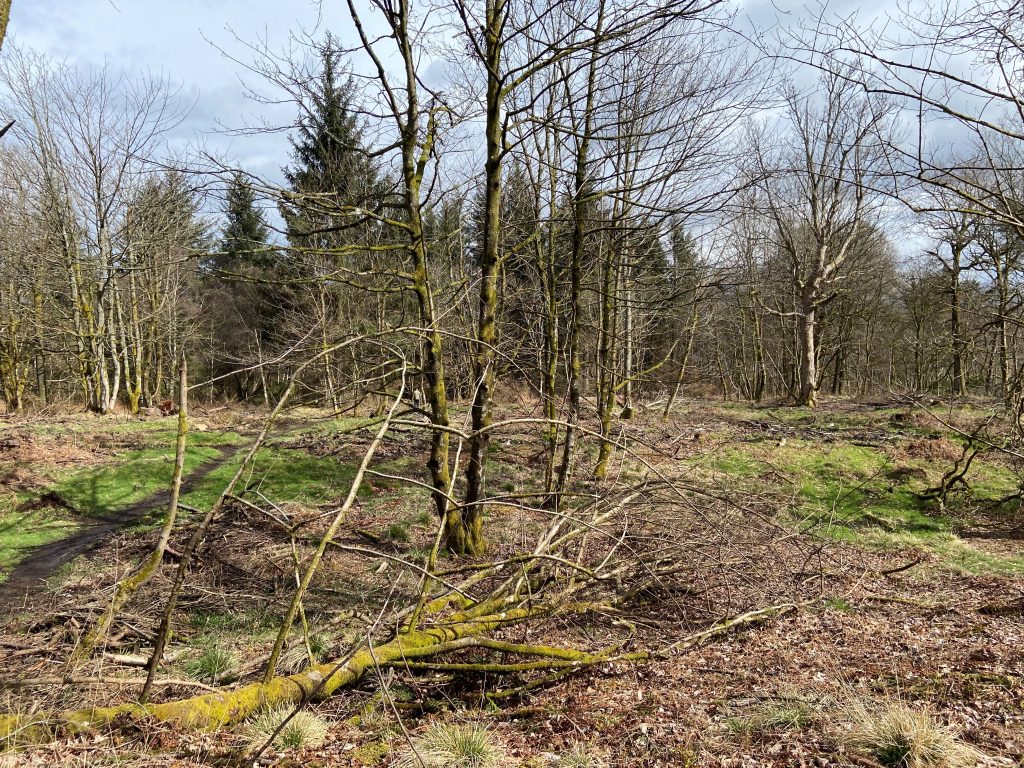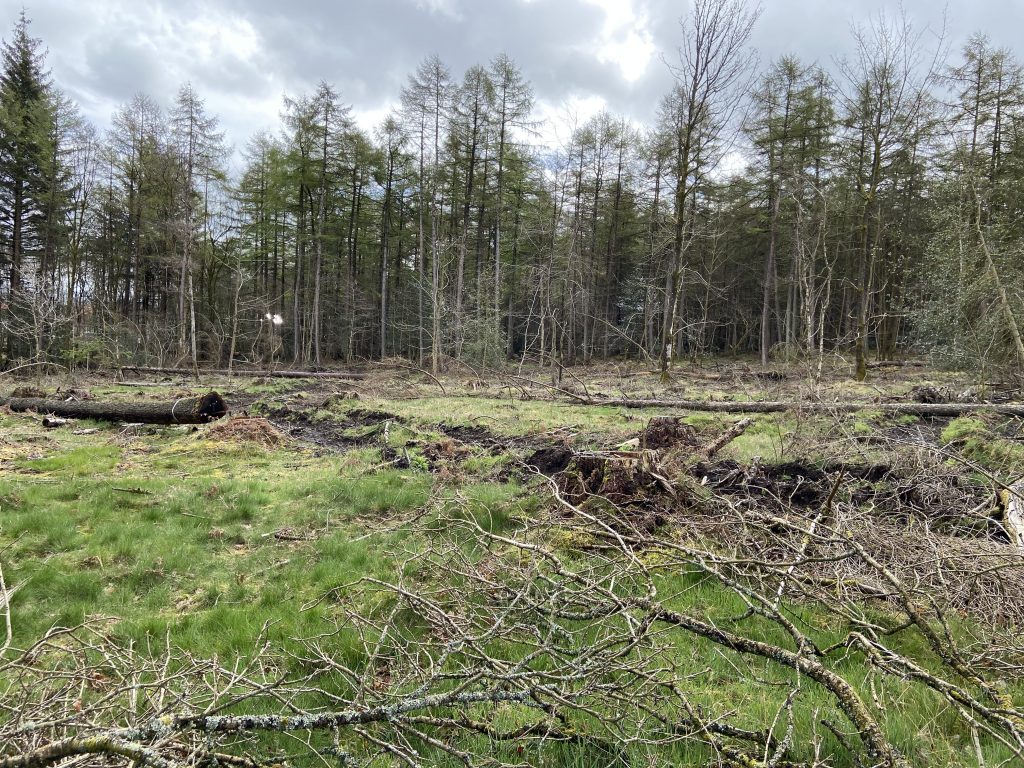“Why are the woods such a mess?” – The challenge of brash management
The CCDT have received a number of comments relating to the amount of waste tree branches (“brash”) left on the ground in key parts of the woodland, following the felling works last winter. In particular the unsightliness and messy appearance this gives to a recreational community woodland.
This post aims to provide some context behind this issue, and describe the key considerations and options for dealing with the brash going forward as part of the planned tree re-stocking project for the woodland.

Why was the felling required?
In late 2021, the CCDT were served with a Statutory Health Plant Notice (SPHN) by Scottish Forestry, due to the presence of the tree disease Phytophthora ramorum (commonly known as Larch Disease) on larch specimens within the woodland. The SPHN required the Trust (by law) to clear the affected Larch trees and, as a precaution, all other Larch trees within a 250m radius.
The SPHN Document can be read in full here.
Since the CCDT completed felling within our portion of the woodland, our neighbouring landowners (Patersons and Tllicoultry Quarries) have also been served with similar SPHNs. Patersons Quarries in particular hand-felled their larch “to waste” (i.e. leaving it on the ground), which has unfortunately created a significant mess near key paths that is outside of our control.
What is P. Ramorum and how does it spread?
P. Ramorum is a destructive, algae-like organism that affects a large number of tree species, but in particular larch. It spreads when the needles produce spores (sporulation) at certain times of the year which can then be spread through mists, air currents, watercourses and rain splash, as well as on footwear, dogs’ paws and mountain-bike wheels (Ramorun disease – Forest Research Website). However, when an affected tree is felled, it will no longer sporulate, and therefore the risk of disease spread is reduced.

Why is so much brash left after the felling?
The SPHN notice specifically required all branches (commonly referred to as “brash”) to be retained on site to minimise the risk of disease spread. The forestry contractor therefore felled and removed (under licence) the main tree stems, but left the brash in situ.
More info on the felling process can be found here https://ccdt.org.uk/spring-2023-sphn-faqs/
Clearly, the more heavily felled the area, the more brash is left. At our woodland, there are a number of areas in particular that were densely larch-dominated, where tree cover is now very limited and there is a heavier cover of brash on the ground. Additionally, during felling/extraction the contractor created “brash mats” (https://cdn.forestresearch.gov.uk/2006/02/fcpn013.pdf) in some areas to provide protection to the ground from heavy vehicle movement.
Before felling, a number of larch trees were also identified as containing suspected squirrel dreys, and Scottish Forestry granted an exemption to allow these to be felled outside of the nesting season. These were subsequently felled by hand later in 2022 and not extracted (to avoid any further vehicle movement/damage). These felled trees currently remain in situ and still have their branches attached, which adds to the visible brash and obstructs movement in these areas.
Additionally, there are a small number of additional windblown trees that have come down since the felling, due to them now being exposed to the wind where they were previously sheltered by the (now felled) larch.

Is there is risk of disease spread from the remaining brash?
We have contacted Scottish Forestry for advice on the potential risk of disease spread from the leftover brash. They have confirmed that, whilst the felling will prevent the production of new spores, existing spores on the brash and ground can remain viable for some time afterwards. Whilst these spores are less likely to disperse in the wind, they could still be spread by footwear etc.
We therefore ask any woodland users to stick to the cleared paths where possible, and clean soil and leaves from their shoes and tyres before visiting any other woodland area, in line with Scottish Forestry’s advice campaign.
We will be renewing the signs previously erected in the woodland to advise of this.

What is going to happen to the brash?
We understand that many in the community have concerns regarding the appearance of the felled areas of woodland, and in particular the leftover brash. The brash is probably at its most prominent recently in winter/early spring before seasonal ground vegetation grows back up.
It is important to note too that (if left) brash will naturally decompose, gradually returning nutrients and carbon back into the soil (https://cdn.forestresearch.gov.uk/2006/02/fcpn013.pdf). During that time it provides an important habitat for insects, nesting birds and other woodland wildlife. (https://www.woodlandtrust.org.uk/blog/2021/03/plant-life-cycle-seeds-shoots-roots/)
We are currently looking at options for the restocking of the SPHN area, and brash management is an important element of this. https://ccdt.org.uk/planning-update-restocking-the-sphn-area/
There are a number of options for managing the brash on site, all of which have benefits and drawbacks that need to be considered (https://cdn.forestresearch.gov.uk/2006/02/fcpn013.pdf).
These include:
- Leaving in place and allowing it to naturally decompose – Whilst unsightly, this would require the least intervention/disruption. However re-planting could be trickier to carry out in areas of heavy brash coverage;
- Clearing back and stacking into piles or rows – This may make re-planting easier in the cleared areas, and the rows may deter deer browsing the young trees, but would likely require mechanical vehicle work. Piles/rows make excellent natural habitats, however they can be difficult to walk across and may be unsightly for a community woodland near the main paths;
- Chipping or mulching – This would create a tidier site visually, would retain nutrients/carbon on site and make re-planting easier, but would be expensive and time consuming for such as large site;
- Burning – Burning is becoming less common as a means of brash management due to the inherent risks and damaging effect on the soil, and it is unlikely to be appropriate in the Community Woodland for a variety of reasons. However, it is noted as an option as part of the SPHN from Scottish Forestry, so is included here, and would reduce the extent of brash left on the ground.
It is possible that a combination of these approaches could be used, depending on the location and extent of brash left on the ground, with the priority being given to more heavily used areas by the Community and to assist with replanting.
How can I share my views and/or get involved?
We plan to consult with the community ahead of the SPHN replanting, and will communicate details on this in due course.
In the meantime, if you have any questions or comments, please email woodland@ccdt.org.uk or come along to one of our volunteer days.

